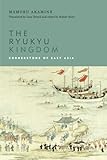The Ryukyu Kingdom : Cornerstone of East Asia / Mamoru Akamine; ed. by Robert Huey.
Material type: TextPublisher: Honolulu : University of Hawaii Press, [2016]Copyright date: ©2016Description: 1 online resource (216 p.) : 16 b&w illustrationsContent type:
TextPublisher: Honolulu : University of Hawaii Press, [2016]Copyright date: ©2016Description: 1 online resource (216 p.) : 16 b&w illustrationsContent type: - 9780824855178
- 9780824855208
- 952/.2902 23
- DS895.R95 A3713 2017eb
- online - DeGruyter
- Issued also in print.
| Item type | Current library | Call number | URL | Status | Notes | Barcode | |
|---|---|---|---|---|---|---|---|
 eBook
eBook
|
Biblioteca "Angelicum" Pont. Univ. S.Tommaso d'Aquino Nuvola online | online - DeGruyter (Browse shelf(Opens below)) | Online access | Not for loan (Accesso limitato) | Accesso per gli utenti autorizzati / Access for authorized users | (dgr)9780824855208 |
Browsing Biblioteca "Angelicum" Pont. Univ. S.Tommaso d'Aquino shelves, Shelving location: Nuvola online Close shelf browser (Hides shelf browser)

|

|

|

|

|

|

|
||
| online - DeGruyter Javaphilia : American Love Affairs with Javanese Music and Dance / | online - DeGruyter Imagining Exile in Heian Japan : Banishment in Law, Literature, and Cult / | online - DeGruyter Holy Ghosts : The Christian Century in Modern Japanese Fiction / | online - DeGruyter The Ryukyu Kingdom : Cornerstone of East Asia / | online - DeGruyter Coral and Concrete : Remembering Kwajalein Atoll between Japan, America, and the Marshall Islands / | online - DeGruyter Siam's New Detectives : Visualizing Crime and Conspiracy in Modern Thailand / | online - DeGruyter Murder Frames the Scene : A Hawai'i Mystery / |
Frontmatter -- Contents -- Author's Note -- Translators' Note and Acknowledgments -- Introduction. What Do We Mean by the "Ryukyu Kingdom"? -- 1. The Gusuku Period -- 2. Founding of the Ming Dynasty and the Rise of the Ryukyu Kingdom -- 3. Ryukyu in the East Asian Trade Sphere -- 4. The Ryukyu Kingdom under the Bakuhan System -- 5. Reform and Sinification of the Kingdom -- 6. The Ryukyu Kingdom's Tribute Trade -- 7. The Imperial Investiture System and the Ryukyu Kingdom -- 8. The End of the Kingdom -- Afterword. Traces of the Ryukyu Kingdom -- Notes -- Bibliography -- Index -- About the Author
restricted access online access with authorization star
http://purl.org/coar/access_right/c_16ec
This English translation of a key work by one of Okinawa's most respected historians, Mamoru Akamine, provides a compelling new picture of the role played by the Ryukyu Kingdom in the history of East Asia. Okinawa Island, from which the present-day Japanese prefecture derives its name, is the largest of the Ryukyu Islands, an archipelago that stretches between Japan and Taiwan. In the present volume, Akamine chronicles the rise of the Ryukyu Kingdom in the fourteenth and fifteenth centuries, when it played a major part in East Asian trade and diplomacy. Then Ryukyu was indeed the cornerstone in a vibrant East Asian trade sphere centered on Ming China, linking what we now call Japan, Korea, and China to Southeast Asia. With historical and cultural connections to both Japan and China, Ryukyu also mediated diplomatically between the two nations, whose leaders more often than not refused to deal with each other directly. But eventually the kingdom became a victim of its own success. Political developments in China and Japan starting in the sixteenth century brought great changes to the region, and in 1609 Ryukyu was invaded by Satsuma, Japan's southernmost domain. The China-Japan geopolitical rivalry would in time be acted out within Ryukyu itself, as one faction strove to maintain ties with China while another supported union with rapidly modernizing Japan. Throughout the work Akamine's approach to Ryukyu history is distinguished by his expert use of Chinese and Korean sources, which allows him to examine events from several different angles. This contributes to a broad, sweeping narrative, revealing an East Asia made up of many shifting and interrelated parts-not just nation states pursuing their own interests. Akamine's facility with Chinese texts in particular uncovers telling details that add considerably to the historical record. His meticulous account of one of Ryukyu's tribute missions to China, for example, or the role of feng shui in the design of Shuri Castle, the royal and administrative center of the kingdom, is detailed without being pedantic. As a result, readers will come away with a broader, more informed understanding of Ryukyu's significance in the region and the complexity of its relations with its neighbors.
Issued also in print.
Mode of access: Internet via World Wide Web.
In English.
Description based on online resource; title from PDF title page (publisher's Web site, viewed 29. Jul 2021)


